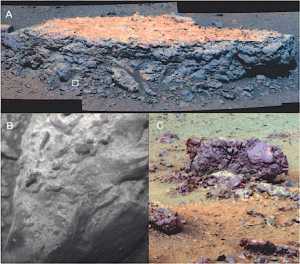Mars Exploration Rover Opportunity reached the south end of Cape York, a segment of the rim of Endeavour Crater about 700 meters (2,300 feet) long, on August 9, 2011. Scientists and engineers examined several targets there before driving the rover to an over-wintering site at the north end of the rim segment. Opportunity has been spending the Martian winter at Greeley Haven.

TISDALE. A false-color Pancam image shows Tisdale, a foot-high block of ejecta from the small crater Odyssey. A close-up view (B) shows it's made of rocky fragments of all sizes welded together by impact melt. This probably indicates an origin in the impact that formed Endeavour Crater. Image C shows yard-wide Kidd Creek, another block of breccia. (Image taken from Figure 3 in the paper.)
Endeavour Crater spans 22 kilometers (14 miles) rim to rim and dates to the Noachian Era, the oldest period in Martian geologic history, more than 3.7 billion years ago. Project scientists led by Steven Squyres (Cornell University) have now published (May 3, 2012) a report in Science which gives details about the rocks of the Shoemaker Formation, which make up Cape York.
This formation is an impact-shattered rock unit (dubbed a breccia), which is a common feature at impact craters. The breccia is made of fragments (called clasts) of the target rock, the ancient basalts of Meridiani Planum, mixed with impact-melted rock.
As noted back in December, the geological story of Cape York combines rocks, impact energy, and groundwater. Scientists identified several rocks and outcrops that embodied parts of the story. The new report extends the findings.
“We suggest that Tisdale [a foot-high rock] may represent the main breccia unit of the rim,” the team writes. “And Chester Lake [a yard-wide rock] and the rocks near Greeley Haven were emplaced later in the impact flow.”
Making a gently sloping bench all around Cape York are sandstones that belong to the same flat-lying sedimentary rocks that Opportunity landed on in January 2004 — and on which it spent its entire mission up until it arrived at Cape York. Cutting into this bench are several thin bright veins. Opportunity studied one of these veins, dubbed Homestake, and found it was almost pure gypsum.
The scientists say, “The gypsum veins at Cape York provide clear evidence for relatively dilute water at moderate temperature, perhaps supporting locally and transiently habitable environments.
“More broadly,” they continue, “rocks at Cape York appear to record early events in a transition from (commonly) hydrothermal waters that altered basaltic crust to phyllosilicates to sulfate-charged ground waters that generated salt-rich sandstones deposited widely over the Meridiani plains and elsewhere.”
Summing up, the team says, “The ubiquity of impact breccia at Cape York contrasts with the only other Noachian terrain explored in situ, the Columbia Hills in Gusev Crater. The rover Spirit encountered great lithologic diversity there, including materials interpreted as impact ejecta. However, none were breccias, and none had the lateral extent of the Shoemaker formation.
“We suggest that the difference can be attributed to Opportunity’s sampling of the rim deposits of a single large crater, rather than Spirit’s sampling of more distal ejecta from multiple impacts.”









Pingback: EDUCATION TECHNOLOGY | Hani Dalqamouni